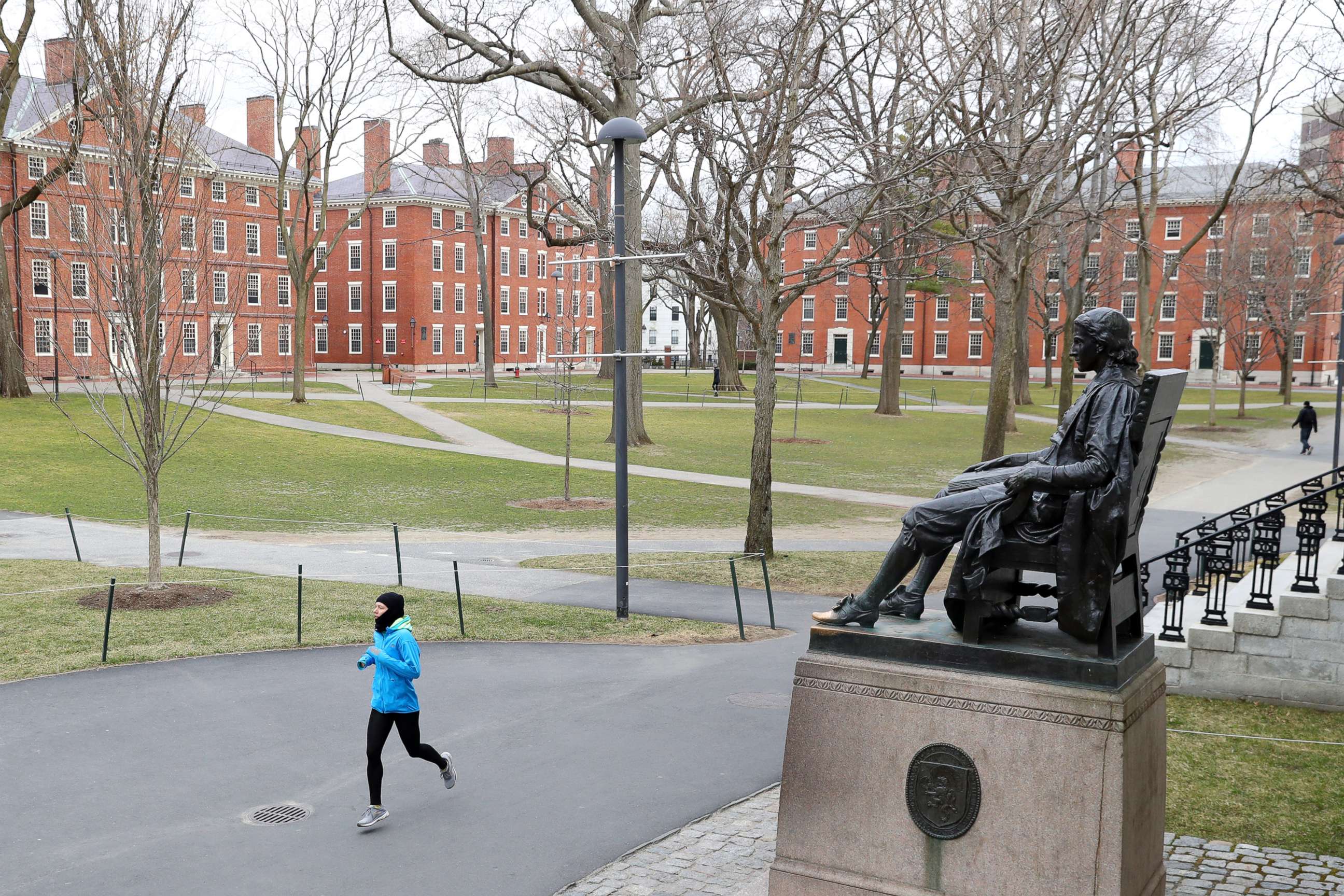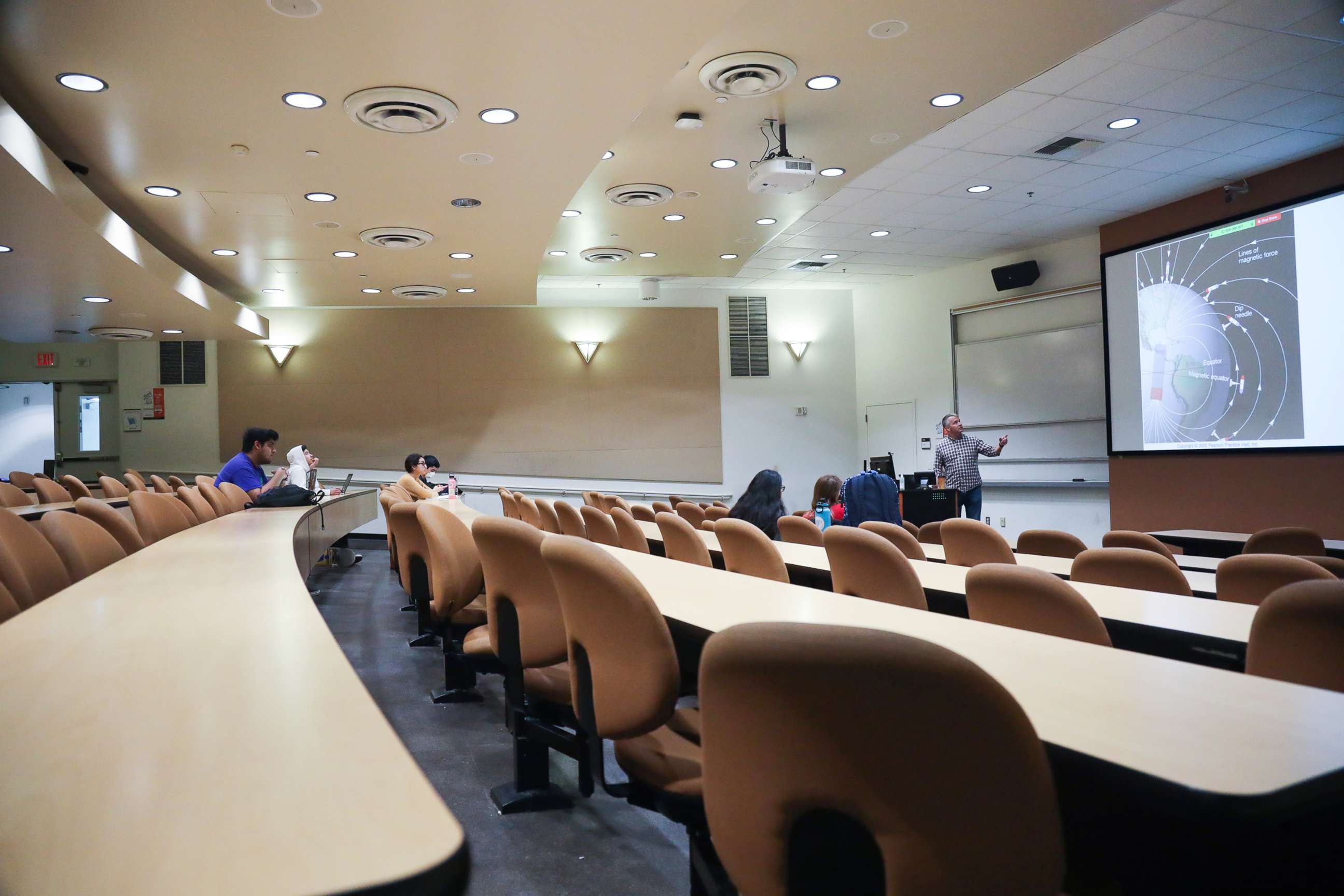How the fall semester could play out at US colleges
Universities are planning for a number of scenarios.
Delaying the start of the semester. Alternating blocks of students in lecture halls. One course for weeks at a time.
Those are some of the scenarios that might play out this fall, as colleges across the country brainstorm ways to limit contact among students and faculty and staff members amid the coronavirus pandemic.
Many schools abruptly emptied lecture halls and dorms in March and transitioned to remote learning for the rest of the spring semester in response to stay-at-home orders and other social distancing measures. Some institutions, such as Boston University and the University of Pittsburgh, have extended campus closures through the summer.
With the start of the fall semester several months away, schools are planning for many different scenarios.
"I think all schools are clamoring for something that probably is unknowable, which is, What's August going to look like?" Peter McDonough, vice president and general counsel for American Council on Education, told ABC News.
"I think everyone's really waiting on this week-by-week, day-by-day type of information on the big questions -- antibody testing and convalescent therapy," Tom Green, associate executive director of consulting and SEM for American Association of Collegiate Registrars and Admissions Officers, told ABC News.
As a result, new students are equally unmoored. By this time of year, many incoming college freshmen have decided where they're going to school in the fall. They may have submitted their first deposit and are thinking about who their roommate might be. Instead, decision day deadlines have been pushed back at hundreds of schools and, with rare exceptions, there are more questions than answers about the fall.
"This is just a level of uncertainty where no one can really answer the question for them," Green added. "We don't know. And that's a terrible place to be as a prospective college student."
Returning students, of course, also are affected. A national survey from ACE and the AACRAO released last week found that 83% of currently enrolled U.S. college students still plan to enroll in the fall, while 12% or uncertain or no longer plan to enroll due to COVID-19.

Following their own playbook
With stay-at-home orders in various stages across the country, a school in Texas may feel emboldened to open up sooner than a school in New York. Each institution is following its own playbook and timeline.
A small number of colleges have announced their intent to open their campuses in the fall, Inside Higher Ed reported. For the most part, though, most schools have communicated to students that they will be open in some form, whether that means on campus, virtually or a mix of both.
In a message released on Monday, Harvard University provost Alan M. Garber was firm in the school's decision to reopen for fall 2020, but said it would be communicating specific plans for fall courses "in the days and weeks ahead."
As some institutions begin to provide insight into the decision-making process and timeline, it appears there may be more answers in June.
The University of Colorado, Boulder is scheduled to announce fall plans on or before June 1.
"Our fall 2020 plans, enrollment projections and state and federal budget scenarios will begin to take clearer shape during the next three weeks," Provost Russell Moore and Interim Chief Operating Officer Patrick O'Rourke wrote in a letter to faculty and staff on Monday.
The University of Illinois told students it will provide updates on fall instruction by mid-June, and for now to assume fall classes would begin in-person as scheduled.
Cal State Fullerton Associate Vice President for Strategic Communications Ellen Treanor pointed to the end of the faculty's contracts as a deciding factor.
"We're hoping to have everything decided by the 22nd of May," Treanor told ABC News. "But if things change, and this takes a bad turn, then we're going to have to readjust."
Green sees June as the latest schools should get a message out to new students, as advisers do orientation and registration for new students in May and June.
"Every single one of them of course is going to ask, Is this going to be in person? Is it online?" Green said. If students can't get basic questions answered, like registration and move-in dates, they "will begin to rethink their bond and commitment to the institution in the fall."
What to know about the coronavirus:
- How it started and how to protect yourself: Coronavirus explained
- What to do if you have symptoms: Coronavirus symptoms
- Tracking the spread in the U.S. and worldwide: Coronavirus map
Tune into ABC at 1 p.m. ET and ABC News Live at 4 p.m. ET every weekday for special coverage of the novel coronavirus with the full ABC News team, including the latest news, context and analysis.
‘Plan for the worst, hope for the best'
If universities are cautiously hopeful about an on-campus start to the fall, behind the scenes, in task force Zoom calls, they are preparing for anything.
"It feels like there isn't a spreadsheet that can have all of the options on it," said Treanor. "There's not a spreadsheet that's big enough."
Treanor is on Cal State Fullerton's infectious disease task force, which was formed in February and is involved in the school's response during the pandemic. It's guided by the latest information and protocols from the Orange County Health Department, the California State University system and the governor's office.
Right now, the strategy is "plan for the worst, hope for the best," Treanor said.
One option that hasn't been mentioned by many schools is taking a gap semester.
"No private institution I know has yet been talking about that," Robert Zemsky, chair of the Learning Alliance for Higher Education at the University of Pennsylvania's Graduate School of Education, told ABC News.
Some institutions are considering the reality of delaying the start of the semester on campus. Boston University's Recovery Plan acknowledges an in-person return could be January 2021 "in the unlikely event that public health officials deem it unsafe to open in the fall of 2020."
AACRAO has heard from several schools on a semester system, which usually begins in August, that are considering a delayed start given the "amount of time it takes to plan and try and execute any of this."
Class size and scheduling to accommodate social distancing also poses a challenge, Green said.
"The really tough parts of that are when you have, say, 30 to 50,000 students in a fixed geographic campus, there are only so many places to have classes," Green said. "It's actually very, very difficult to figure out if it could even be possible if you did it 24/7, seven days a week just to even make that work."
To limit contact between students, Green could see schools having blocks of students that take classes together, or take one course at a time for several weeks. Cornell College in Iowa already follows the latter model. This week, the private school announced it will break up its 2020-2021 school year into 10, instead of its standard eight, blocks. That way, students can delay the start of their academic year and still have the option to graduate in four years. It also gives the school the flexibility to delay on-campus instruction.
"We are prepared to start the year on campus, which is our goal," President Jonathan Brand said in a statement. "If necessary, though, we are also prepared to take it block-by-block, starting the academic year online and pivoting back to campus when it is safe to do so."
Beloit College, a small private school in southern Wisconsin, plans to change both the start and structure of its fall semester. Instead of taking four courses in a semester, the semester will be split in half, with students taking two courses over seven weeks. The fall semester was pushed back two weeks, to Sept. 8.

Virtual plan B
Right now, going completely remote for the start of the fall semester is "plan B" for most schools, Green said.
On "Good Morning America," Purdue University President Mitch Daniels said he's hearing from students, "telling us they want to be here and want us to make that possible and safe for them, and for those around them." The Indiana school hopes to start opening its campus July 1.
Schools may lose students if all-remote instruction continues into the fall. In a recent survey, Tyton Partners found that over 40% of parents are uncertain or would not send their child to school for the fall semester in a remote-learning scenario.
Still, schools are preparing for that. In an AACRAO survey of college officials, 58% of respondents said their colleges are considering or have decided to go fully online for the fall semester. Nearly three-quarters of responders -- 73% -- also are considering increasing or have increased the number of remote courses, and 62% are considering decreasing or have decreased the number of in-person courses.
A blend of remote and face-to-face colleges is a real possibility. Cal State Fullerton is working on a "phased approach," Treanor said. "I'm super optimistic that we'll start in some sort of hybrid form in the fall, then transition back to in-person, face-to-face. That seems to be what the students want. They want the full campus experience."
While nothing is decided yet, that could look like a class with half the students in person and half virtual; students rotating in-person throughout the week; or it could be all online until "social distancing is relaxed," Treanor said. Larger auditorium classes, which fit up to 250, may be in-person later, while smaller lab classes "that are least likely to lend themselves to virtual environments" would be a priority to start, she said.
Lately, there has been optimism about the possibility of face-to-face classes starting in the fall, said Treanor. But there is always the concern about a second wave of infections.
"We want to be as flexible as possible," Treanor said. "There's a lot we do know. There's a lot we don't know."
ABC News' Andy Fies and James Hill contributed to this report.




